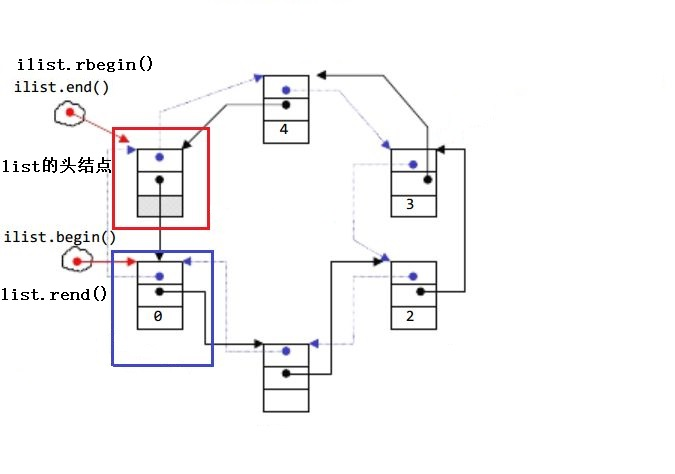C++STL之list详解
一.list的定义与使用
1.list的定义
list即链表,并且是带头结点的双向循环链表。在模拟实现时我们会重点讲解list结点结构,迭代器结构和链表整体结构。
2.list的使用
1.list的构造
可以看到list的构造方式与vector的构造方式类别上差不多
| 构造函数( (constructor)) | 接口说明 |
| list (size_type n, const value_type& val = value_type()) | 构造的list中包含n个值为val的元素 |
| list() | 构造空的list |
| list (const list& x) | 拷贝构造函数 |
| list (InputIterator first, InputIterator last) | 用[first, last)区间中的元素构造list |
list<int> lt1;
lt1.push_back(1);
lt1.push_back(2);
lt1.push_back(3);
lt1.push_back(4);list<int> lt2(lt1);print_container(lt1);
print_container(lt2);list<int> lt3;
lt3.push_back(10);
lt3.push_back(20);
lt3.push_back(30);
lt3.push_back(40);lt1 = lt3;
print_container(lt1);
print_container(lt3);//隐式类型转换可以匹配下面提到的initializer_list
// 直接构造
list<int> lt0({ 1,2,3,4,5,6 });
// 隐式类型转换
list<int> lt1 = { 1,2,3,4,5,6,7,8 };
const list<int>& lt3 = { 1,2,3,4,5,6,7,8 };2.list的迭代器
list指针不是一个简单的原生指针,因为list的空间不是连续的内存空间,++或者--等操作需要进行具体的封装,因此这里的list迭代器是一个类类型,后面会详细讲解。实际上迭代器本身就具有封装属性,用户在使用迭代器时的行为都没有太大区别,但因容器本身结构差异较大,底层对迭代器的实现也不尽相同。
| 函数声明 | 接口说明 |
| begin + end | 返回第一个元素的迭代器+返回最后一个元素下一个位置的迭代器 |
| rbegin + rend | 返回第一个元素的reverse_iterator,即end位置,返回最后一个元素下一个位置的reverse_iterator,即begin位置 |

3.list的容量管理
| 函数声明 | 接口说明 |
| empty | 检测list是否为空,是返回true,否则返回false |
| size | 返回list中有效节点的个数 |
4.list的元素访问
| 函数声明 | 接口说明 |
| front | 返回list的第一个节点中值的引用 |
| back | 返回list的最后一个节点中值的引用 |
5.list的增删查改
| 函数声明 | 接口说明 |
| push_front | 在list首元素前插入值为val的元素 |
| pop_front | 删除list中第一个元素 |
| push_back | 在list尾部插入值为val的元素 |
| pop_back | 删除list中最后一个元素 |
| insert | 在list position 位置中插入值为val的元素 |
| erase | 删除list position位置的元素 |
| swap | 交换两个list中的元素 |
| clear | 清空list中的有效元素 |
3.list中出现的迭代器失效问题
相较于其他地址空间连续的容器,list的迭代器失效问题就少了不少,但依然存在。list的底层结构为带头结点的双向循环链表,因此在list中进行插入时是不会导致list的迭代器失效的,只有在删除时才会失效,并且失效的只是指向被删除节点的迭代器,其他迭代器不会受到影响。
解决方法也很简单,只需要更新新的迭代器位置即可
void TestListIterator()
{ i
nt array[] = { 1, 2, 3, 4, 5, 6, 7, 8, 9, 0 };
list<int> l(array, array+sizeof(array)/sizeof(array[0]));
auto it = l.begin();
while (it != l.end())
{
l.erase(it++); // it = l.erase(it);
}
}二.list的模拟实现
#pragma once
#include<assert.h>
#include<iostream>namespace wjh {//结点template<class T>struct list_node {//带头双向循环链表//一个结点需要记录前后结点T _data;list_node<T>* _next;list_node<T>* _prev;list_node(const T&data=T()):_data(data),_next(nullptr),_prev(nullptr){}};//迭代器是一个类类型template<class T,class Ref,class Ptr>struct list_iterator { //需要重载++,--,*,==,!=等操作typedef list_node<T> Node;//模板实例自引用typedef list_iterator<T,Ref,Ptr> Self;Node* _node;list_iterator(Node* node):_node(node){}Ref operator*() const{return _node->_data;}Ptr operator->() const{return &_node->_data;}Self& operator++(){_node = _node->_next;return *this;}Self& operator--(){_node = _node->_prev;return *this;}// 后置++Self operator++(int) {Self tmp = *this;_node = _node->_next;return tmp;}Self operator--(int) {Self tmp = *this;_node = _node->_prev;return tmp;}//注意这里比较传入的是迭代器,而不是Node对象??bool operator==(const Self& rhs) const{return _node == rhs._node;}bool operator!=(const Self& rhs) const{return _node != rhs._node;}};template<class T>class list {typedef list_node<T> Node;public:typedef list_iterator<T, T&, T*> iterator;typedef list_iterator<T, const T&, const T*> const_iterator;iterator begin(){return _head->next;}iterator end(){return _head;}const_iterator begin() const{return _head->_next;}const_iterator end() const{return _head;}// 初始化的一个统一方法,创建一个头结点//并且将两指针指向头结点自身void empty_init(){_head = new Node;_head->_next = _head;_head->_prev = _head;_size = 0;}list() {empty_init();}//花括号列表 {1, 2, 3} 会被转换为 initializer_list<int>list(initializer_list<T> il) {empty_init();for (auto &e : il) {push_back(e);}}//拷贝构造list(const list<T> &l) { empty_init();for (auto &e : l) {push_back(e);}}void swap(list<T>& lt){std::swap(_head, lt._head);std::swap(_size, lt._size);}//重载=,利用swap交换资源list<T> &operator=(const list<T> <) {swap(lt);return *this;}void clear() {auto it=begin();while (it!=end()) {//防止迭代器失效,更新itit=erase(it);}}~list() {clear();delete _head;_head=nullptr;}//头插尾插void push_back(const T &x) { insert(end(),x);}void push_front(const T &x) {insert(begin(),x);}iterator insert(iterator pos, const T &x) { Node* cur = pos._node;Node* prev = cur->_prev;Node* newnode = new Node(x);// prev newnode curnewnode->_next = cur;cur->_prev = newnode;newnode->_prev = prev;prev->_next = newnode;++_size;return newnode;}void pop_back(){erase(--end());}void pop_front(){erase(begin());}iterator erase(iterator pos){assert(pos != end());Node* prev = pos._node->_prev;Node* next = pos._node->_next;prev->_next = next;next->_prev = prev;delete pos._node;--_size;return next;}size_t size() const{return _size;}bool empty() const{return _size == 0;}private:Node* _head;size_t _size;};
}三.知识补充
1.由list的模拟实现我们可以看到,list的迭代器是用一个类进行封装的。因为链表的地址空间并不连续,它自然也不支持用表达式做参数传入erase等函数
it = lt.begin();
lt.erase(it + 3);2.在vector我们就讲过,迭代器按找功能分可以分为普通迭代器,反向迭代器以及const版本的普通迭代器和反向迭代器4种。我们可以再按性质给迭代器分为三类:单向迭代器(如forward_list单链表),双向迭代器(list/map/set)以及随机迭代器(vector/deque/string)。而不同的算法(这里用sort举例)需要的迭代器不同,究其根本是因为各个容器的底层结构不同,可传入连续空间的迭代器的sort自然无法应用在不连续空间的迭代器。
// 不支持,要求随机迭代器
list<int> lt={1,2,3,4,5};
//只能使用list自己的sort
sort(lt.begin(), lt.end());3.再说回迭代器失效,在list中只会出现删除情况下的迭代器失效,但也仅是当前元素的迭代器失效,其他的迭代器仍然正常,借此我们需要对erase函数进行特别注意,在删除元素后返回当前删除元素的下一个元素的迭代器即可
iterator erase(iterator pos){assert(pos != end());Node* prev = pos._node->_prev;Node* next = pos._node->_next;prev->_next = next;next->_prev = prev;delete pos._node;--_size;return next;}
4.按需实例化
在C++模板中有一个“按需实例化”的概念,即:如果不出现语法上编译器能严格检查出来的错误,当前运行程序若并未使用该方法,依旧不会报错。例如对const迭代器指向的对象进行修改:
template<class Container>
void print_container(const Container& con)
{// const iterator -> 迭代器本身不能修改// const_iterator -> 指向内容不能修改typename Container::const_iterator it = con.begin();//auto it = con.begin();while (it != con.end()){//*it += 10;cout << *it << " ";++it;}cout << endl;for (auto e : con){cout << e << " ";}cout << endl;
}